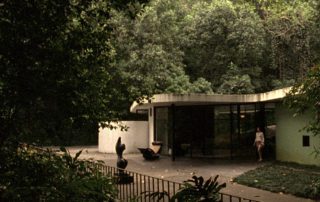An immersive show by Tamar Guimarães and Kaspar Akhøj transforms Bexhill’s De La Warr Pavilion
An exhibition by artists Tamar Guimarães and Kasper Akhøjat the De Lar Warr Pavilion, Bexhill-on-Sea, presents moving image and photographic works selected in response to the modernist architecture of the De La Warr Pavilion, and the curious social history of the coastal town. “I blew on Mr Greenhill’s main joints with a very ‘hot’ breath”, its title, comes from the memoirs of Arthur Spray, a shoemaker who practised healing in there in the 1930s. For much of the last five years, the work of Copenhagen-based artists Guimarães and Akhøj has has also focused on spiritualism, based on research undertaken in Palmelo, a small town in Brazil built in the 1930s around a study group and a sanatorium, many of whose 2000 inhabitants are Spiritist mediums who practise a collective healing form they call the “magnetic chain”. Through this connection, the De La Warr exhibition brings together the disparate histories of Brazil and Bexhill.
A collaborative work from 2014, “Captain Gervàsio’s Family” describes the lengths that one of Palmelo’s mediums underwent to draw a map charting twenty astral cities hovering above Brazil. The cities are described as “like those on earth but infinitely more perfect” and entail a splendid vision of modernity. The film juxtaposes footage of the mediums in action, with modernist architecture in Brasilia, São Paulo and Rio de Janeiro. It invites us to imagine that these buildings might have been projected from the bodies of the mediums like ectoplasm; materialising the astral cities they describe and suggesting that these real and imagined places could be an embodiment of utopian thought.
The artists’ most recent film, “Studies for a Minor History of Trembling Matter” (2017) follows two of Palmelo’s Spiritist mediums. The exhibition also includes Akhøj’s “Welcome (To the Teknival)”, a series of photographs taken in France between 2009 and 2017 during the restoration of Eilen Gray’s villa E-1027, Maison en bord de mer. Akhøj’s photographs reproduce Gray’s original compositions from the photographs she made in 1929, capturing the process of change.
Guimarães’ film “Canoas” (2010) is set around a staged cocktail party in Casa das Canoas, the home that Oscar Niemeyer built for himself in Rio de Janeiro in 1951. The comings and goings of waiters and butlers suggest a series of interactions, many of them in tension with the utopian aspirations of the modernist project and the unequal social relations on which it could be seen as grounded.
Unfolding throughout the exhbition space, an undulating curtain designed in collaboration with Frederico Fazenda, echoes curtains seen in photographs of the Pavilion when it first opened, and curves found in Niemeyer’s work, while suggesting here a veil between the earth and the spirit world.
The exhibition runs until 3 June; for more details visit http://www.dlwp.com



























